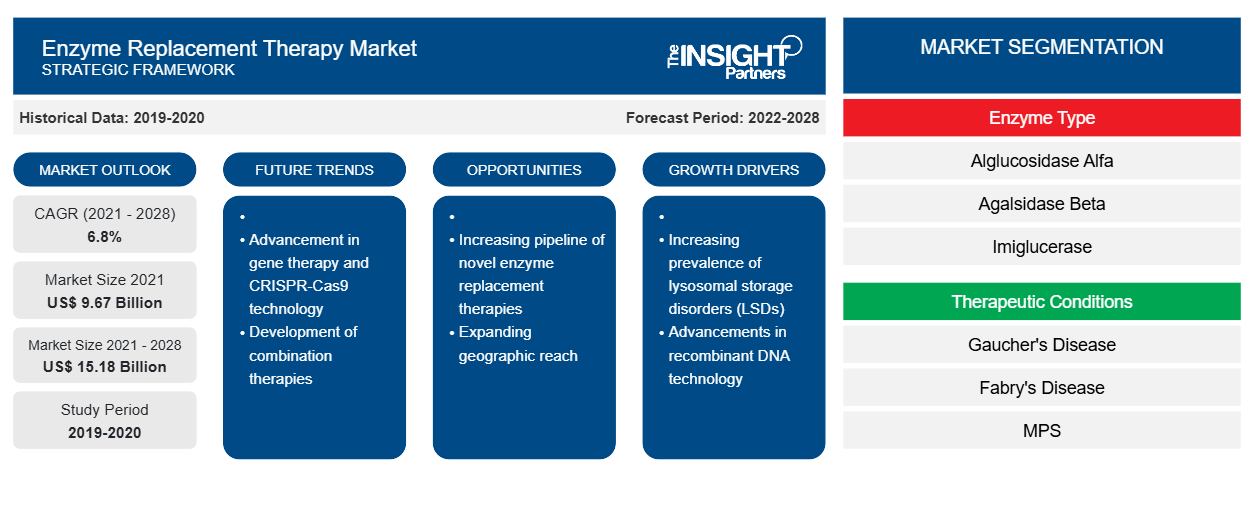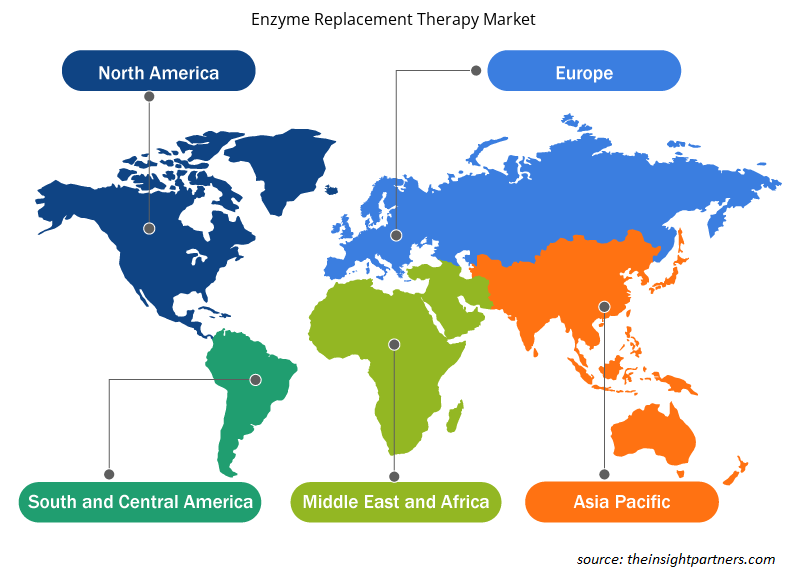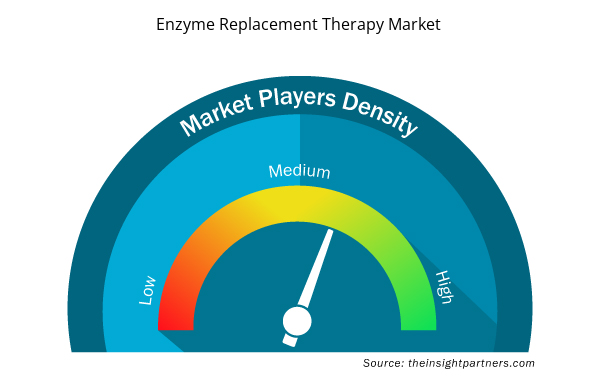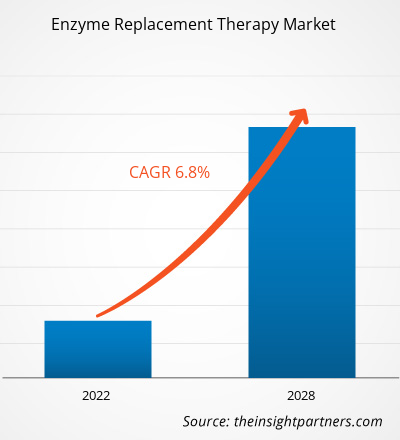The enzyme replacement therapy market is expected to grow from US$ 9,673.39 million in 2021 to US$ 15,184.70 million by 2028; it is estimated to grow at a CAGR of 6.8% from 2022 to 2028.
Enzyme replacement therapy (ERT) is performed to treat congenital enzyme deficiencies by using enzyme or protein having enzymatic activity. Animal, human, and recombinant engineered enzymes are a few sources of enzyme required for treatment. The therapy is generally applied in rare and lysosomal storage diseases, including Pompe disease, Fabry disease, Gaucher disease, Tay-Sachs disease, and Hurler syndrome. The most common ERT method is IV infusions, in which the replacement enzyme is administered directly into the bloodstream through a controlled drip of fluids. The growth of the global enzyme replacement therapy market is attributed to the rising prevalence of lysosomal storage diseases (LSDs) and rapid regulatory approval with other marketing benefits for drug with orphan drug designation. However, the cutthroat competition among market players hinders the market growth.
The report offers insights and in-depth analysis of the global enzyme replacement therapy market, emphasizing various parameters including market trends, technological advancements, market dynamics, and competitive landscape analysis of global leading market players. It also includes the impact of the COVID-19 pandemic on the market across all regions. Due to the COVID-19 pandemic, many health authorities focused on pandemic-related care. Moreover, many patients requiring enzyme replacement therapy missed their infusions in March 2020 due to the inadequacy of hospital services dealing with the burden of COVID-19 patients. Patients requiring ERT claimed to feel anxious during hospital admissions or regarding drug supply. Also, studies revealed that some patients had depression and an increased amount of anxiety. Thus, scheduled enzyme replacement therapy (ERT) sessions were disrupted during COVID-19 pandemic leading to a negative impact on the market.
Customize This Report To Suit Your Requirement
You will get customization on any report - free of charge - including parts of this report, or country-level analysis, Excel Data pack, as well as avail great offers and discounts for start-ups & universities
Enzyme Replacement Therapy Market: Strategic Insights

- Get Top Key Market Trends of this report.This FREE sample will include data analysis, ranging from market trends to estimates and forecasts.
Customize This Report To Suit Your Requirement
You will get customization on any report - free of charge - including parts of this report, or country-level analysis, Excel Data pack, as well as avail great offers and discounts for start-ups & universities
Enzyme Replacement Therapy Market: Strategic Insights

- Get Top Key Market Trends of this report.This FREE sample will include data analysis, ranging from market trends to estimates and forecasts.
Geography-Based Insights
By geography, the global enzyme replacement therapy market is segmented into North America (the US, Canada, and Mexico), Europe (France, Germany, the UK, Spain, Italy, and the Rest of Europe), Asia Pacific (China, India, Japan, Australia, South Korea, and the Rest of APAC), the Middle East & Africa (Saudi Arabia, the UAE, South Africa, and the Rest of the MEA), and South & Central America (Brazil, Argentina, and the Rest of South & Central America).
Market Insights
Rising Prevalence of Lysosomal Storage Diseases (LSDs)
A lysosome is a membrane-bound cell organelle that contains digestive enzymes. A lysosome is the key cellular hub for macromolecule catabolism, recycling, and signaling. Any defect in these functions leads to the accumulation or storage of macromolecules in lysosomes, resulting in cellular damage. The leading cause of lysosomal storage diseases (LSDs) is mutations in the genes responsible for encoding a lysosomal enzyme. Additionally, LSDs are characterized as an inborn metabolism error that results in an enzyme's absence or deficiency. Infants and children suffer more severely compared to adults as children can inherit the defective gene from one or both parents. However, since the last decade, the pattern has been changing, and LSDs are more common in adults
Moreover, LSDs are approximately 70 diseases, including Gaucher disease, Niemann-Pick disease, Fabry disease, Tay-Sachs disease, Mucopolysaccharidoses (MPS) diseases, and Pompe disease. These disorders are individually rare, but collectively they are significantly prevalent and affect 1 in 5,000 live births. Many countries conducted surveys to understand the prevalence pattern, and the overall prevalence was rising. For instance, a study published in The Lancet Regional Health entitled "Prevalence of lysosomal storage disorders in Australia from 2009 to 2020". The study revealed the following outcomes:
- The prevalence in the Australian population is 1.6 times (1 per 4,800 live births), higher than the reported prevalence in 1996 (1 per 7,700 live births).
- Fabry disease was most prevalent, representing 34% of all diagnoses (up to 2020).
- LSDs are more common in adulthood than in childhood
Thus, the rising prevalence of LSDs and limited therapies to cure the disease are driving the growth of the global enzyme replacement therapy market
Enzyme Type-Based Insights
Based on enzyme type, the global enzyme replacement therapy market is segmented into alglucosidase alfa, agalsidase beta, imiglucerase, idursulfase, galsulfase, velaglucerase alfa, and other enzymes. In 2021, the other enzymes segment accounted for the largest market share. The same segment is expected to register the highest CAGR in the market from 2022 to 2028.
Therapeutic Conditions-Based Insights
Based on therapeutic conditions, the global enzyme replacement therapy market is segmented into Gaucher's disease, Fabry's Disease, Pompe's Disease, SCID, MPS, and other therapeutic conditions. The Gaucher’s disease segment held the largest market share in 2021 and is expected to register the highest CAGR during the forecast period.
Route of Administration-Based Insights
Based on route of administration, the global enzyme replacement therapy market is bifurcated into parenteral and oral. The parenteral segment held a larger market share in 2021 and is anticipated to register a higher CAGR during the forecast period.
Enzyme Replacement Therapy Market Regional Insights
Enzyme Replacement Therapy Market Regional Insights
The regional trends and factors influencing the Enzyme Replacement Therapy Market throughout the forecast period have been thoroughly explained by the analysts at Insight Partners. This section also discusses Enzyme Replacement Therapy Market segments and geography across North America, Europe, Asia Pacific, Middle East and Africa, and South and Central America.

- Get the Regional Specific Data for Enzyme Replacement Therapy Market
Enzyme Replacement Therapy Market Report Scope
| Report Attribute | Details |
|---|---|
| Market size in 2021 | US$ 9.67 Billion |
| Market Size by 2028 | US$ 15.18 Billion |
| Global CAGR (2021 - 2028) | 6.8% |
| Historical Data | 2019-2020 |
| Forecast period | 2022-2028 |
| Segments Covered |
By Enzyme Type
|
| Regions and Countries Covered | North America
|
| Market leaders and key company profiles |
Enzyme Replacement Therapy Market Players Density: Understanding Its Impact on Business Dynamics
The Enzyme Replacement Therapy Market market is growing rapidly, driven by increasing end-user demand due to factors such as evolving consumer preferences, technological advancements, and greater awareness of the product's benefits. As demand rises, businesses are expanding their offerings, innovating to meet consumer needs, and capitalizing on emerging trends, which further fuels market growth.
Market players density refers to the distribution of firms or companies operating within a particular market or industry. It indicates how many competitors (market players) are present in a given market space relative to its size or total market value.
Major Companies operating in the Enzyme Replacement Therapy Market are:
- Sanofi
- BioMarin Pharmaceutical Inc.
- Takeda Pharmaceutical Company Limited
- AbbVie Inc.
- Janssen Pharmaceuticals (Johnson & Johnson Services, Inc.)
Disclaimer: The companies listed above are not ranked in any particular order.

- Get the Enzyme Replacement Therapy Market top key players overview
End User-Based Insights
Based on end user, the global enzyme replacement therapy market is segmented into hospitals, infusion centers, and others. The hospitals segment held the largest market share in 2021. However, the infusion centers segment is expected to register the highest CAGR during the forecast period.
The global enzyme replacement therapy market players adopt organic strategies, including product launch and expansion, to expand their footprint and product portfolio worldwide and meet the growing demand. A few major players contributing to the market are Takeda Pharmaceutical Company Limited; Sanofi S.A.; AbbVie Inc.; BioMarin Pharmaceutical Inc.; Amicus Therapeutics; Alexion Pharmaceuticals, Inc. (AstraZeneca); Janssen Pharmaceuticals (Johnson & Johnson Services, Inc.); Recordati S.p.A.; Pfizer Inc.; and CHIESI Farmaceutici S.p.A.
- Historical Analysis (2 Years), Base Year, Forecast (7 Years) with CAGR
- PEST and SWOT Analysis
- Market Size Value / Volume - Global, Regional, Country
- Industry and Competitive Landscape
- Excel Dataset


- Embolization Devices Market
- Radiopharmaceuticals Market
- Health Economics and Outcome Research (HEOR) Services Market
- Water Pipeline Leak Detection System Market
- MEMS Foundry Market
- Print Management Software Market
- Hot Melt Adhesives Market
- Volumetric Video Market
- EMC Testing Market
- Bathroom Vanities Market

Report Coverage
Revenue forecast, Company Analysis, Industry landscape, Growth factors, and Trends

Segment Covered
Enzyme Type, Therapeutic Conditions, Route of Administration, and End-User

Regional Scope
North America, Europe, Asia Pacific, Middle East & Africa, South & Central America

Country Scope
Argentina, Australia, Brazil, Canada, China, France, Germany, India, Italy, Japan, Mexico, Saudi Arabia, South Africa, South Korea, Spain, United Arab Emirates, United Kingdom, United States
Frequently Asked Questions
Global enzyme replacement therapy market is segmented by region into North America, Europe, Asia Pacific, Middle East & Africa, and South & Central America. In North America, the U.S. is the largest market for enzyme replacement therapy market. A rise in the prevalence of lysosomal storage diseases such as Gaucher’s, Pompe’s, and Fabry’s diseases, increasing regulatory approval, favorable regulatory support by the government, and the availability of various ERT products will drive enzyme replacement therapy market growth in North America. However, the growing government funding for rare disease treatment, increasing clinical trials, an increasing number of product approvals, and expanding partnerships among key players are the key factors responsible for the Asia-Pacific regional growth of the enzyme replacement therapy market accounting fastest growth in the region during the coming years.
The hospitals segment dominated the global enzyme replacement therapy market and accounted for the largest market share of 49.00% in 2021.
Takeda Pharmaceutical Company Limited, Sanofi, AbbVie Inc., BioMarin Pharmaceutical Inc., Amicus Therapeutics, Alexion Pharmaceuticals, Inc.(AstraZeneca), Janssen Pharmaceuticals (Johnson & Johnson Services, Inc.), Recordati S.p.A., Pfizer Inc., and CHIESI Farmaceutici S.p.A. are among the leading companies operating in the enzyme replacement therapy market
Based on route of administration, parenteral route of administration segment took the forefront lead in the worldwide market by accounting largest share in 2021 and is expected to continue to do so till the forecast period.
Based on therapeutic conditions, Gaucher's disease segment took the forefront lead in the worldwide market by accounting largest share in 2021 and is expected to continue to do so till the forecast period.
Based on enzyme type, other enzymes segment took the forefront lead in the worldwide market by accounting largest share in 2021 and is expected to continue to do so till the forecast period. Other enzymes include taliglucerase, laronidase, agalsidase alfa, eliglustat, cipaglucosidase alfa, miglustat, elosulfase alfa, elapegademase, velmanase alfa, pancreatic enzymes, pegademase, sebelipase alfa, cerliponase alfa, among others.
Enzyme replacement therapy (ERT) is a treatment that replaces enzymes that are not present or are deficient in the body. This is usually done by giving the patient an intravenous (IV) infusion or oral solution in which the enzyme is present. ERT is available for various lysosomal storage diseases which include Fabry’s disease, Gaucher’s disease, Pompe’s disease, MPS, and others. The ERT only increases the concentration of the enzymes which is lacking in the patient body and it does not correct any underlying genetic defect. ERT has also been used to treat patients with severe combined immunodeficiency (SCID) resulting from an adenosine deaminase deficiency (ADA-SCID).
Rising prevalence of lysosomal storage diseases (LSDS) and rapid regulatory approval with other benefits for drug with orphan drug designation are the most significant factors responsible for the overall market growth.
Trends and growth analysis reports related to Life Sciences : READ MORE..
The List of Companies - Enzyme Replacement Therapy Market
- Sanofi
- BioMarin Pharmaceutical Inc.
- Takeda Pharmaceutical Company Limited
- AbbVie Inc.
- Janssen Pharmaceuticals (Johnson & Johnson Services, Inc.)
- Alexion Pharmaceuticals, Inc (AstraZeneca)
- Amicus Therapeutics
- Recordati S.p.A.
- CHIESI Farmaceutici S.p.A.
- Pfizer Inc.

 Get Free Sample For
Get Free Sample For